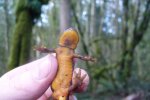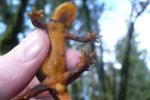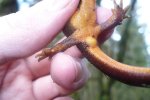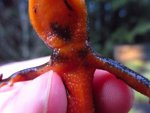sde
Well-known member
- Joined
- Apr 5, 2012
- Messages
- 1,892
- Reaction score
- 58
- Points
- 48
- Location
- Seattle area Washington
- Country
- United States
- Display Name
- Seth
Hello everyone,
So I wanted to share some pictures of oddly colored T. granulosa I have found. I have found three in the last five months, but only have pictures of two.
One is a adult male ( the one I don't have pictures of ). He was found ( like both the others ) crossing the road. I dismisst it though, thinking he was just a random oddball. I wish I wouldn't have though, and would have taken a picture. But my first thought when I looked at his belly was "he looks like a T. mazamae!" But I just thought maybe he was an oddly colored one and moved on.
So here's the best description I can give. He was a normal looking newt from the top, but it was his belly that was odd. I flipped him over and he had the dark from his dorsal running into his belly more than usual. So basically the dark on the sides of his belly were farther in towards the middle of his belly than any other T. granulosa I have ever seen. So he sort of looks like a T. mazamae. Man am I kicking myself for not taking a picture, learned my lesson though.
Number two. My juvenile T. granulosa Nemo. I will attach pictures of him at the end.
Nemo has some add coloration to him, he's not an average looking T. granulosa. He is spotted, pretty much all over his dorsal surfaces, and his tail. But not his belly. I honestly don't have a clue why this would be. But it is very interesting. I am keeping him, so well see what happens. He doesn't look like a T. mazmae but he does have very odd coloration/pigmentation.
Number three. Yesterday I found a extremely oddly colored female T. granulosa, or at least from what I know. I will attach several pictures of her as well.
So, yesterday I was biking to the marsh where they breed to see if I could find any males, when I saw her crossing the road. From the top she looked like a normal T. granulosa, ( like the male I found ), but her underside was a different story! On her throat there a dark spot, definitely no dirt, it was pigmentation. But her legs were odd too. All of the T. granulosa that I have found have had orange colored legs on the underside, but hers weren't. They were dark. All the way to her hands. Everything else about her was normal, but here throat had a large spot and the undersides of her legs were dark. It was very odd, and prompted me to make this thread.
So what's going on here? Is it normal to find oddly colored T. granulosa? Or is there some significance to this?
Thanks! -Seth
So I wanted to share some pictures of oddly colored T. granulosa I have found. I have found three in the last five months, but only have pictures of two.
One is a adult male ( the one I don't have pictures of ). He was found ( like both the others ) crossing the road. I dismisst it though, thinking he was just a random oddball. I wish I wouldn't have though, and would have taken a picture. But my first thought when I looked at his belly was "he looks like a T. mazamae!" But I just thought maybe he was an oddly colored one and moved on.
So here's the best description I can give. He was a normal looking newt from the top, but it was his belly that was odd. I flipped him over and he had the dark from his dorsal running into his belly more than usual. So basically the dark on the sides of his belly were farther in towards the middle of his belly than any other T. granulosa I have ever seen. So he sort of looks like a T. mazamae. Man am I kicking myself for not taking a picture, learned my lesson though.
Number two. My juvenile T. granulosa Nemo. I will attach pictures of him at the end.
Nemo has some add coloration to him, he's not an average looking T. granulosa. He is spotted, pretty much all over his dorsal surfaces, and his tail. But not his belly. I honestly don't have a clue why this would be. But it is very interesting. I am keeping him, so well see what happens. He doesn't look like a T. mazmae but he does have very odd coloration/pigmentation.
Number three. Yesterday I found a extremely oddly colored female T. granulosa, or at least from what I know. I will attach several pictures of her as well.
So, yesterday I was biking to the marsh where they breed to see if I could find any males, when I saw her crossing the road. From the top she looked like a normal T. granulosa, ( like the male I found ), but her underside was a different story! On her throat there a dark spot, definitely no dirt, it was pigmentation. But her legs were odd too. All of the T. granulosa that I have found have had orange colored legs on the underside, but hers weren't. They were dark. All the way to her hands. Everything else about her was normal, but here throat had a large spot and the undersides of her legs were dark. It was very odd, and prompted me to make this thread.
So what's going on here? Is it normal to find oddly colored T. granulosa? Or is there some significance to this?
Thanks! -Seth










